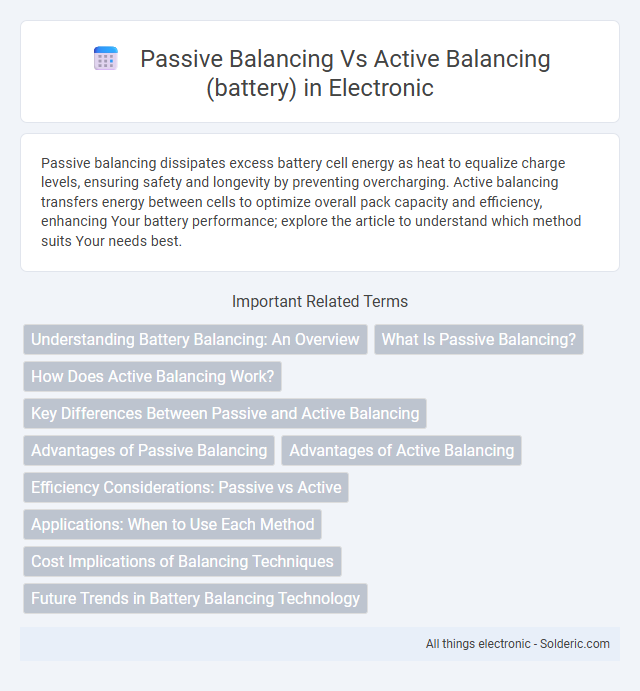Passive balancing dissipates excess battery cell energy as heat to equalize charge levels, ensuring safety and longevity by preventing overcharging. Active balancing transfers energy between cells to optimize overall pack capacity and efficiency, enhancing Your battery performance; explore the article to understand which method suits Your needs best.
Comparison Table
| Feature | Passive Balancing | Active Balancing |
|---|---|---|
| Definition | Dissipates excess energy as heat from higher voltage cells. | Transfers energy from higher voltage cells to lower voltage cells. |
| Energy Efficiency | Low - wastes energy as heat. | High - conserves energy within the battery pack. |
| Cost | Lower initial cost and simpler design. | Higher cost due to complex circuitry and components. |
| Complexity | Simple and easy to implement. | Complex with active energy transfer mechanisms. |
| Heat Generation | Generates significant heat during balancing. | Minimal heat generation. |
| Balancing Speed | Slower balancing process. | Faster balancing process. |
| Battery Lifespan Impact | Potentially reduces battery life due to heat. | Prolongs battery life by maintaining cell balance efficiently. |
| Use Cases | Suitable for small or low-cost battery packs. | Ideal for large, high-value battery systems (e.g., EVs, energy storage). |
Understanding Battery Balancing: An Overview
Battery balancing ensures all cells within a battery pack maintain equal voltage levels, crucial for optimal performance and extended lifespan. Passive balancing dissipates excess energy from higher-voltage cells as heat, while active balancing redistributes energy between cells to maximize efficiency. Understanding the differences helps you choose the best method for your specific battery management system needs.
What Is Passive Balancing?
Passive balancing involves dissipating excess energy from battery cells as heat using resistors to equalize charge levels, ensuring each cell maintains optimal voltage. This method is simple, cost-effective, and widely used in battery management systems, but it results in energy loss and reduced overall efficiency. Understanding passive balancing helps you determine its suitability for applications where simplicity outweighs energy conservation.
How Does Active Balancing Work?
Active balancing redistributes energy between battery cells by using DC-DC converters or inductors to transfer charge from higher voltage cells to lower voltage ones, enhancing overall battery efficiency. This method minimizes energy loss by dynamically equalizing cell voltages during charging and discharging cycles, extending battery life and maximizing capacity. Compared to passive balancing, which dissipates excess energy as heat, active balancing conserves energy, making it ideal for electric vehicles and renewable energy storage systems.
Key Differences Between Passive and Active Balancing
Passive balancing dissipates excess energy from battery cells as heat through resistors, simplifying design and reducing cost, but resulting in energy loss and slower balancing. Active balancing transfers energy between cells using inductors or capacitors, enhancing efficiency, extending battery life, and improving capacity utilization while increasing system complexity and cost. The key difference lies in energy management: passive balancing wastes surplus energy, whereas active balancing redistributes it for optimal cell leveling.
Advantages of Passive Balancing
Passive balancing offers simplicity and cost-effectiveness by dissipating excess energy as heat to equalize battery cell voltages without the need for complex circuitry. This method enhances safety and reliability through fewer components and lower risk of failure, making it ideal for standard battery management systems in electric vehicles and energy storage. Your system benefits from straightforward implementation and reduced maintenance compared to active balancing alternatives.
Advantages of Active Balancing
Active balancing improves battery efficiency by redistributing energy from higher-charged cells to lower-charged ones, extending overall battery life and enhancing performance consistency. Unlike passive balancing, which dissipates excess energy as heat, active balancing minimizes energy loss, leading to better thermal management and increased system reliability. Your battery system benefits from higher energy utilization and reduced degradation, making active balancing the superior choice for advanced battery management.
Efficiency Considerations: Passive vs Active
Passive balancing dissipates excess energy as heat through resistors, making it less efficient for large battery packs due to energy loss. Active balancing transfers energy between cells using inductors or capacitors, significantly improving efficiency by redistributing charge without energy dissipation. In electric vehicles and renewable energy storage systems, active balancing can enhance battery lifespan and performance while reducing energy wastage.
Applications: When to Use Each Method
Passive balancing suits small to medium-sized battery packs in consumer electronics and electric bikes where cost-effectiveness and simplicity are priorities. Active balancing excels in large-scale energy storage systems and electric vehicles with high-capacity lithium-ion batteries, optimizing charge distribution and extending battery life. Selecting the appropriate method depends on the application's power requirements, battery size, and budget constraints.
Cost Implications of Balancing Techniques
Passive balancing involves dissipating excess energy as heat through resistors, resulting in lower upfront costs but higher energy losses and reduced overall system efficiency. Active balancing uses energy transfer circuits to redistribute charge between cells, leading to higher initial investment but improved energy conservation and extended battery life. Your choice between these methods should consider both the cost implications and long-term performance benefits.
Future Trends in Battery Balancing Technology
Future trends in battery balancing technology emphasize the integration of advanced active balancing systems that enhance energy efficiency by redistributing charge among cells with minimal loss compared to traditional passive methods. Innovations in semiconductor materials and intelligent control algorithms are enabling real-time monitoring and adaptive balancing, extending battery lifespan and improving overall system reliability. Emerging applications in electric vehicles and grid storage solutions drive the demand for scalable, smart balancing techniques that optimize performance under diverse operating conditions.
Passive balancing vs Active balancing (battery) Infographic

 solderic.com
solderic.com